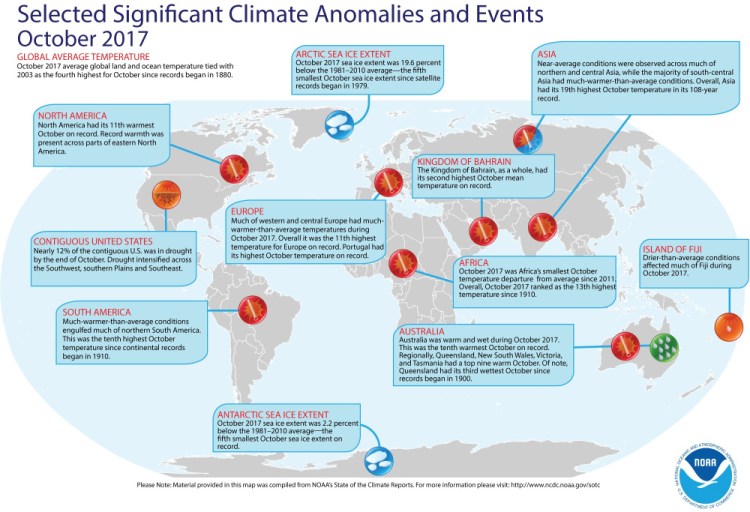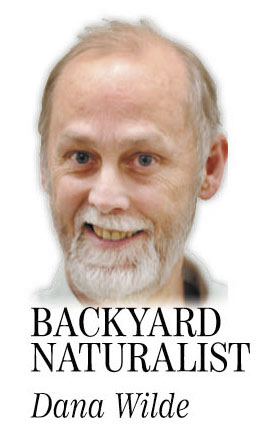Since I was a teenager people have been muttering that the world has gone crazy. But in the past year and a half, it seems almost literally true. Every day seems weirder than the day before.
Among the many bewildering things that happen, the most bewildering to me are the denials of climate change. People talk about it as if it’s a matter of opinion, like whether the Patriots stand a chance of winning another Super Bowl. It’s not an opinion. It’s a scientific fact. The changing climate is creating conditions for monumental natural disasters right before our eyes — such as, but not limited to, the destruction of Puerto Rico and parts of Texas and Florida in huge storms; drought causing unprecedented wildfires out West; melting glaciers; crashing fisheries; submerging islands and coastlines.
What’s even more baffling is that while it matters hardly a jot to most people’s health and well-being who wins the Super Bowl, it’s of critical worldwide concern how we deal with climate change. And yet, almost daily, in the shadows of other events and tweets that seem even more obliteratively insane, environmental initiatives and policies intended to grapple with global warming are being systematically — no, it’s not systematic, it’s persistently haphazard, which is even worse — climate change initiatives and policies are being deliberately dismantled.
It feels like willful self-destruction. It reminds me of a sentence written during World War I, another insane time: “Stupidity carried beyond a certain point becomes a public menace.”
Anyway, here is your occasional Backyard Naturalist update on indications of the hell-bentness of the recent trajectory.
BEWILDERING
• A United Nations Environment Programme report this month states that “it is extremely unlikely that the (Paris Climate Accord’s) goal of holding warming below 2 degrees Celsius can still be reached.”
• The U.S. government is now the only one in the world not cooperating with the Paris accord since Syria announced last month it is joining the effort.
• President Trump’s nominee to head the White House Council on Environmental Quality, Kathleen Hartnett White, told the Senate this month she thinks the extent of human contribution to climate change is “very uncertain” and “more precise explanations of the human role and the natural role” are needed. I don’t know if any senators alerted her that thousands of precise explanations by climate scientists over the last 40-plus years are available for her to read.
• Environmental Protection Agency Director Scott Pruitt is taking steps to replace scientists with oil and chemical industry officials as EPA advisers. One observer noted that Pruitt had “nearly halved the number of university scientists and tripled the number of industry and consulting firm scientists” on the Scientific Advisory Board.
• Trump nominated a chemical industry consultant to head the EPA’s Office of Chemical Safety and Pollution Prevention. As a consultant, Michael Dourson has defended demonstrably unsafe chemicals, sometimes at odds not only with the findings of federal regulators but also with the chemical companies themselves.
• On Nov. 9, the EPA proposed a rule repealing tighter emissions standards for heavy-duty trucks with older engines. The original regulation aimed to control pollutants and greenhouse-gas emissions linked to climate change. Even trucking groups and engine manufacturers supported the rule, which was to take effect in January.
• Trump this month issued an executive order to reduce the Bears Ears and Grand Staircase-Escalante national monuments by about 1.1 million acres and about 800,000 acres respectively. The land can now be opened to “energy exploration” and other uses that tend to degrade the Earth. The Native American tribes who worked toward the creation of the monuments are suing the president.
• The Global Carbon Budget 2017 prepared by 76 scientists in 15 countries indicates that global carbon emissions have increased 2 percent in 2017, to 37 billion tons. The previous three years had seen no increase. The rise is blamed in part on a spike in coal use in China.
• The World Meteorological Organization Greenhouse Gas Bulletin for October reported that carbon dioxide in the atmosphere rose at a record-breaking speed in 2016 to the highest level in 800,000 years. Average concentrations of CO2 spiked to 403.3 parts per million in 2016, up from 400.00 ppm in 2015 because of a combination of human activities and a strong El Niño event. Concentrations of CO2 are now 145 percent of pre-industrial levels, according to the bulletin.
• A study by University of Victoria researchers predicts that “sweltering summers as gauged by a long-standing measurement of human heat tolerance have become at least 70 times more likely over the past four decades. By 2050, virtually every summer will be hotter than any experienced to date.”
GOOD NEWS
• According to the National Oceanic and Atmospheric Administration, the hole in Earth’s ozone layer that forms over Antarctica each September was the smallest since 1988. Ozone helps shield the Earth from dangerous ultraviolet radiation. A worldwide effort to ban ozone-depleting chemicals is largely behind the shrinking of the hole.
• The White House allowed the release of the National Climate Assessment, a report required by law. The report says climate change is driven almost entirely by human action, warns of potential sea-level rise as much as 8 feet by 2100, and describes climate-related damage in the U.S. that is already under way. Why the White House allowed the release of the report is unknown, given that White House officials actively work to discredit climate science (see third bullet point).
• In response to the assessment’s estimate that the annual cost associated with climate change could rise to $35 billion by 2050, U.S. Sen. Susan Collins, R-Maine, said she believes the federal government’s failure to take action will cost U.S. taxpayers too much money. The health of the Earth is one thing, but the health of your bank account — that is of real concern.
CLEANING UP
• In October, South Portland opened a solar farm of 2,900 solar panels. The array is expected to generate 1.2 million kilowatt-hours of renewable energy per year, about 12 percent of the electricity used by the city’s buildings.
• Bath and Cape Elizabeth recently passed ordinances restricting single-use shopping bags and foam containers, joining other Maine municipalities with similar ordinances. Another small step for the health of the Earth.
Dana Wilde lives in Troy. You can contact him at naturalist1@dwildepress.net. His recent book is “Summer to Fall: Notes and Numina from the Maine Woods” available from North Country Press. Backyard Naturalist appears the second and fourth Thursdays each month.
Send questions/comments to the editors.




Success. Please wait for the page to reload. If the page does not reload within 5 seconds, please refresh the page.
Enter your email and password to access comments.
Hi, to comment on stories you must . This profile is in addition to your subscription and website login.
Already have a commenting profile? .
Invalid username/password.
Please check your email to confirm and complete your registration.
Only subscribers are eligible to post comments. Please subscribe or login first for digital access. Here’s why.
Use the form below to reset your password. When you've submitted your account email, we will send an email with a reset code.